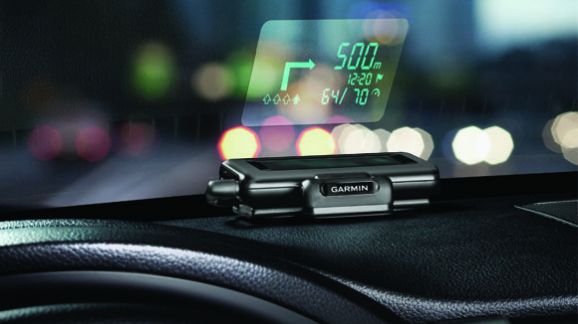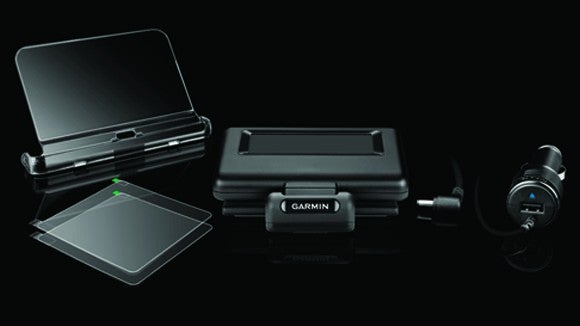Garmin HUD Review
Garmin HUD
Jet fighter-style heads-up display for your mobile sat nav

Sections
- Page 1 Garmin HUD Review
- Page 2 Performance and Verdict Review
Verdict
Pros
- Easy to set up
- Readily visible even in bright sunlight
- Makes you feel like a fighter pilot
Cons
- No full map view
- Only compatible with Garmin and Navigon sat-nav apps
- Single-use device
Key Specifications
- Review Price: £129.00
- Heads-up display projector
- Uses windscreen or built-in translucent screen
- Bluetooth smartphone connection
- Car power adapter with secondary USB power connection
- Compatible with Garmin Streetpilot and Navigon sat-nav apps
What is the Garmin HUD?
The Garmin HUD is a system for projecting directions from your sat-nav onto your windscreen, so you can keep your eyes on the road more easily as you navigate. It’s designed to work with your smartphone software, taking its routing information from this rather than being a standalone navigation device in itself. It doesn’t work with every app out there. Unsurprisingly, it’s designed to function with Garmin’s own software, in particular Streetpilot for iPhone and the Navigon apps for Android, iPhone and Windows Phone that Garmin acquired when it purchased Navigon in June 2011.
SEE ALSO: Best sat nav round-up
Garmin HUD: Design & Features
The Garmin HUD connects to your smartphone via Bluetooth, and is designed to sit on your dashboard so it can project onto the windscreen. The device is slightly shorter than an average smartphone, but thicker and heavier. It sits on a hinged base that has an adhesive bottom and two screw holes, so you can attach it firmly and semi-permanently into your car. Both of these fixing methods might make you a little uncomfortable if you own a premium vehicle you don’t want to modify. The fact that the device is not meant to be removable is also a concern considering how frequently cars are broken into to steal sat navs, or devices that might be sat navs.
Power is provided by the usual cigarette lighter socket, and Garmin has thoughtfully added a secondary USB socket, so you can keep your phone powered at the same time. However, the smartphone screen doesn’t need to be on to transmit directions to the HUD. Once the two devices are paired over Bluetooth, and you have set up your destination, you can leave the smartphone alone and head off on your journey.
However, your smartphone is still the device that is actually doing the navigating. The HUD is merely a projector. So your phone is providing the audio directions, and also the GPS reception, meaning you can’t stuff it away in a glove compartment. You will probably want to have a dashboard phone caddy with good line of sight through your car windows, for the best GPS performance and verbal command audibility.

Anyone who has used projectors for home entertainment or business presentations will attest that bright lighting, particularly sunlight, is very problematic. So a device that doesn’t even have a solidly coloured screen to project onto sounds like it will be doomed to failure unless you are driving at night. Garmin gets around this issue by offering two ways to superimpose the image on your windscreen – an adhesive high-reflective patch that you stick to the inside of the glass, and a built-in translucent screen that attaches directly to the HUD.
Both are pretty effective. We had no problem seeing the directions clearly with either, even in bright direct sunlight. Apart from the traffic, speed and camera warnings, the display uses a light blue-green, which really does stand out. The symbols hang in the air in a way that is extremely hard to illustrate in a photo, but is highly visible. At first, the display is actually more mesmerising than a sat-nav screen, although you quickly get used to it.


